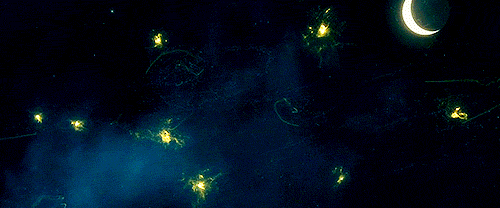Don't wanna be here? Send us removal request.
Photo





The Tomb of the Salamina Fighters, Achilles Vasileiou, 2006
This site overlooks the sea where the famous naval battle of Salamis took place in 480 BC. Honouring the men who fought and died for Greece, this large circular tomb was built using limestone and gravel, and is highlighted with a bronze statue by sculptor Achilleas Vassileiou.
A crucial battle in determining the final outcome of the Persian Wars, the Greek naval fleet was heavily outnumbered, with fewer than 400 small ships against the powerful Persian fleet. The Greeks seemed to be the underdogs until Themistocles developed a plan to fight the battle at a spot favouring the smaller, faster Greek ships. The mighty Persian fleet was destroyed, and the Persian threat to conquer the Peloponnese faded along with it.
204 notes
·
View notes
Text
The Image of Hercules with infant Telephos
The statue of Heracles with infant Telephos which is located in the Chiaramonti Museum is the oldest example of this image, having been created in the 2nd century A.D. as a copy of a Greek statue of the 4th century A.D.

This statue, which was discovered in Rome in the vicinity of Campo de’ Fiori, was one of the first sculptures to come into the Vatican collections. Pope Julius II (1503-1573) exhibited it in the Courtyard of the Statues in the Belvedere. The presence of Heracles, in fact, leads us back to the mythological origins of Rome and alludes in particular to the victory of the Romans over the tribes of ancient Latium. The god Heracles, with his club and lion skin, holds his son Telephos in his arms. Telephos is the son born to Heracles by the priestess Auge who was forced to abandon the child in the mountains of Arcadia, where he was nourished by a doe until he was rescued by his father. Telephos became King of Mysia and one of the leading characters in a rich and complex mythology that sees him involved in the Greek expedition against Troy. This statue is a second century A.D. copy, probably of a Late Hellenistic original.

In The Poison King: The Life and Legend of Mithradates: Rome's Deadliest Enemy, Adrienne Mayor states that "Recent analysis of portraiture in contemporary coins and sculpture suggests that the model for the little boy was none other than Mithradates!"
According to her Pompey the Great recognized the likeness of the baby Telephus to Mithradates and took it to Rome after defeating Mithradates in 63 BC (Mayor): "Pompey installed this Hercules statue in his Theater on the Field of Mars in Rome. The statue was discovered in 1507 in Campo dei Fiori, near the ruins of Pompey's Theater."

After its rediscovery in 1507, the statue became an inspiration for the artists of its time leading to many engravings of the image belonging to the 16th century. The emperor Commodus was pictured in the same pose multiple times in the Speculum Romanae Magnificentiae (published c. 1540-80), inspiring slightly different copies which dates extend into the 18th century. I am not sure if I have acquired all of these copies since there are so many. But here are some;

Emperor Commodus as Hercules, Attributed to Jacob(us) Bos, 1550
This print comes from the museum’s copy of the Speculum Romanae Magnificentiae (The Mirror of Roman Magnificence) The Speculum found its origin in the publishing endeavors of Antonio Salamanca and Antonio Lafreri. During their Roman publishing careers, the two foreign publishers - who worked together between 1553 and 1563 - initiated the production of prints recording art works, architecture and city views related to Antique and Modern Rome. The prints could be bought individually by tourists and collectors, but were also purchased in larger groups which were often bound together in an album. In 1573, Lafreri commissioned a title page for this purpose, which is where the title ‘Speculum Romanae Magnificentiae’ first appears. Lafreri envisioned an ideal arrangement of the prints in 7 different categories, but during his lifetime, never appears to have offered one standard, bound set of prints. Instead, clients composed their own selection from the corpus to be bound, or collected a group of prints over time. When Lafreri died, two-third of the existing copper plates went to the Duchetti family (Claudio and Stefano), while another third was distributed among several publishers. The Duchetti appear to have standardized production, offering a more or less uniform version of the Speculum to their clients. The popularity of the prints also inspired other publishers in Rome to make copies however, and to add new prints to the corpus.
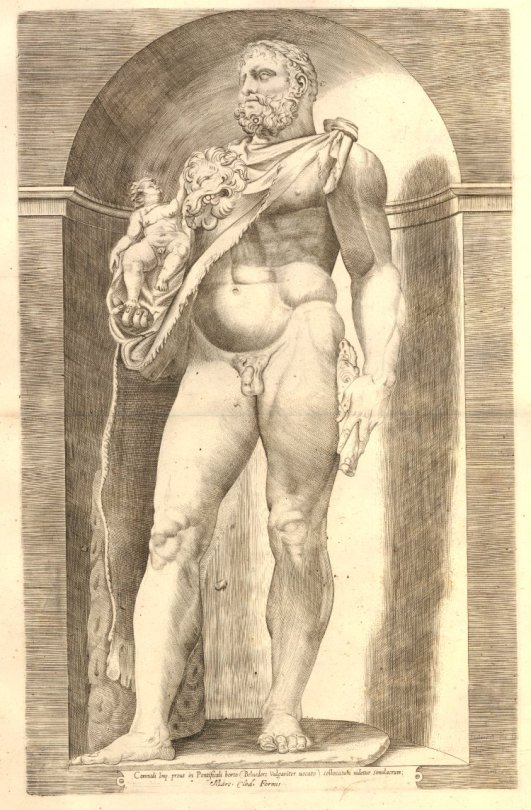
The Emperor Commodus dressed as Hercules, after an antique statue placed in a niche in the Belvedere, Anonymous, 1587-89

Hercules and Telephos, Hendrick Glotzius, c. 1592
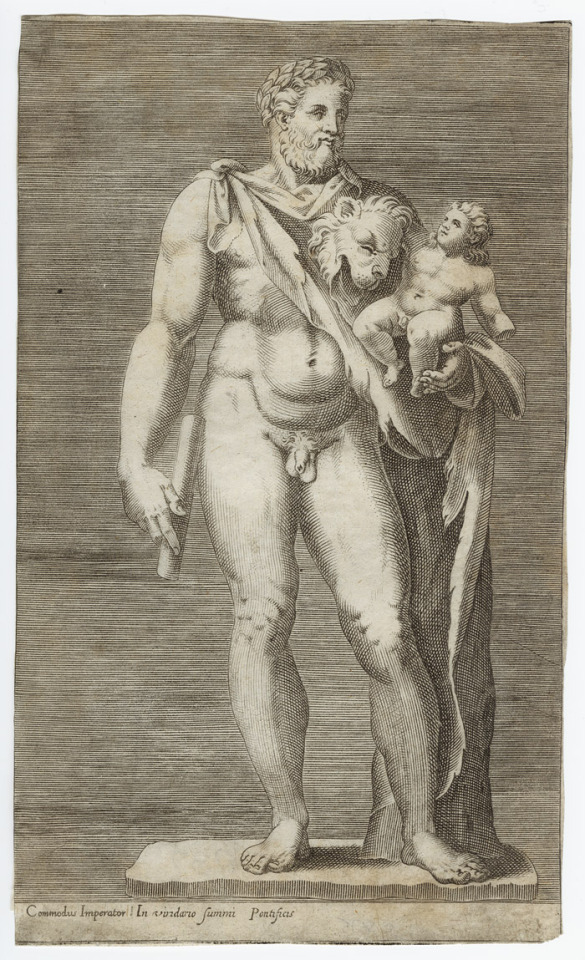
Emperor Commodus in the Papal gardens, after the engraving of Jacob(us) Bos, ca. 1614
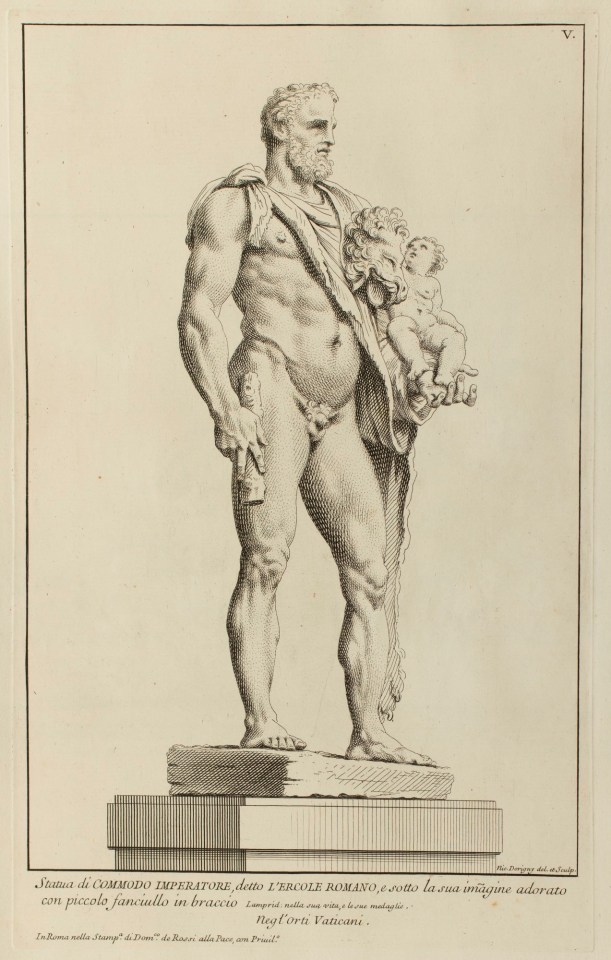
Heracles with infant Telephos, Sir Nicolas Dorigny, 1704
Of course, the statue’s artistic interpretations were not limited to engravings. Here is a terracotta reproduction by Stefano Maderno, dated 1620.

And lastly, I would like to add a very interesting photograph by James Anderson dating 1859 and bearing the name Hercule avec le jeune Ajax. It is a photograph of the sculpture we know today but with the father's genitals covered and the club still intact.
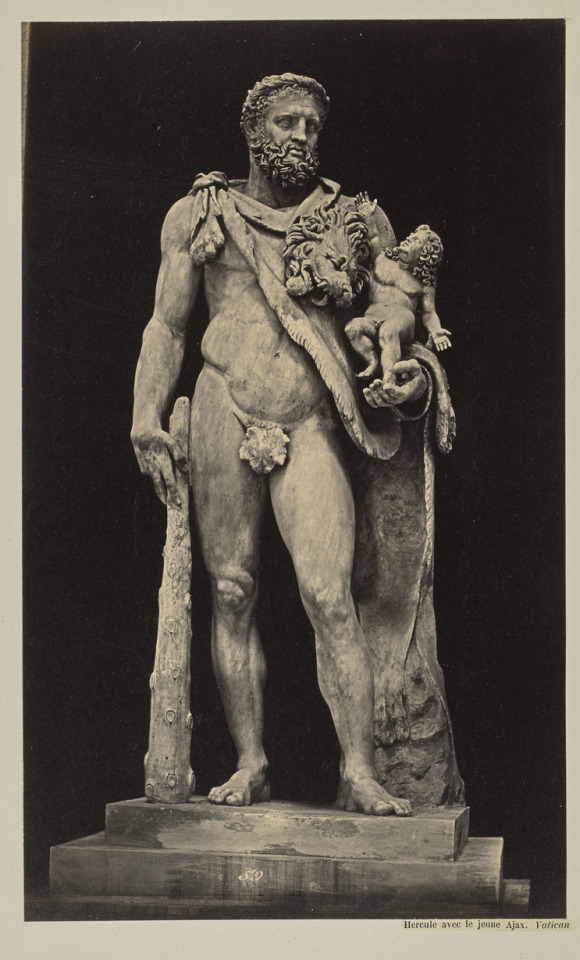
Image Sources:
1. http://www.museivaticani.va/content/museivaticani/en/collezioni/musei/museo-chiaramonti/ercole-e-telefo-bambino.html
2. https://www.flickr.com/photos/askrobotov/48448640202/
3. https://www.flickr.com/photos/hen-magonza/7361370584/
4. https://www.metmuseum.org/art/collection/search/402935
5. https://www.britishmuseum.org/research/collection_online/collection_object_details.aspx?assetId=340981001&objectId=3064979&partId=1
6. https://www.artic.edu/artworks/112044/hercules-and-telephos-plate-two-from-three-famous-antique-sculptures
7. http://speculum.lib.uchicago.edu/search.php?search%5B0%5D=commodus&searchnode%5B0%5D=all&result=7
8. https://www.royalacademy.org.uk/art-artists/work-of-art/heracles-with-infant-telephos-kown-as-commodo-imperatore-or-ercole-romano
9. shorturl.at/fgDJ9
10. http://www.getty.edu/art/collection/objects/218216/james-anderson-hercule-avec-le-jeune-ajax-vatican-british-1859/?dz=0.4745,0.4745,0.74
#greek art#roman art#hellenistic#hercules#herakles#telephos#herakles and telephos#vatican#musei vaticani#vatican museums#sculpture
67 notes
·
View notes
Photo

Diana en Akteon (Diana and Actaeon), Dirck Barendsz (designer) & Jacques de Gheyn II. (engraver), around 1590
In his early period, de Gheyn engraved two scenes by painter Dirck Barendsz (1534-1592). This Amsterdam artist spent seven years in Italy in Tizian's workshop and was among the prominent Mannerist artists who brought their Italian experience to the Netherlands. The print depicts a mythological story from Ovid's Metamorphoses. It describes how Diana, the goddess of the hunt, bathed in a forest lake along with her companions. Actaeon, grandson of the king of Thebes, got lost in the forest while hunting and, having stumbled upon the lake, saw Diana and her nymphs naked. As a punishment, the goddess turned him into a deer. Later, his own dogs hunted him down and torn him to pieces. Actaeon's tragic end is depicted on the right in the background.
It is currently part of the Schwarzenberg Palace gallery in Prague
51 notes
·
View notes
Photo










Masky (The masquerades), Jacques de Gheyn II., 1595 - 1596
Each sheet from this arresting cycle of then copper engravings represents three figures wearing masks and comical costumes. These are likely carnival or theatre figures; some of them refer directly to commedia dell'arte. De Gheyn had a close relationship to theatre and even acted in one play. Masks erasing people's personal and social identities were also worn during the carnival, an event that turned a familiar city into a great illusion. The title page featuring a poem by Hugo Grotius inscribed in a tomb-shaped aedicula gives the whole series the moralizing undertone of a memento mori. A man and a woman stand praying on each side of the tomb, while a skeleton removes masks from their faces. The cycle can therefore be interpreted as an allegory of the worldly theatre: we act throughout our lives but no mask holds up against death and we meet eternity stark naked.
This collection is currently part of the Schwarzenberg Palace gallery in Prague
42 notes
·
View notes
Photo


Omnium rerum vicissitudo est, title page, Jacques de Gheyn II. (1565 - 1629), 1595 - 1596 (design)
Omnium rerum vicissitudo est, title page, Zacharias Dolendo (1561 - 1601), ca. 1596 - 1597 (engraving)
De Gheyn was not just a reproductive engraver. He also created his own designs, such as the present sheet depicting the personifications of virtues and vices, a popular theme in the period. The cycle consists of eight depictions of figures and a title page which features the same figures riding the wheel of fortune. There is a causal relationship between individual virtues and vices: on the top right, Fortune (woman with a banner) leads to Wealth which causes Pride (bottom right) followed by Envy (bottom). The latter leads to War (bottom left) which brings Poverty (left), followed by Faith (top left). At the very top, the sunlit Peace sits on the throne and rules the earth.
The first work is exhibited in Rijksmuseum, Amsterdam and the second work in the Schwarzenberg Palace Gallery in Prague
30 notes
·
View notes
Photo
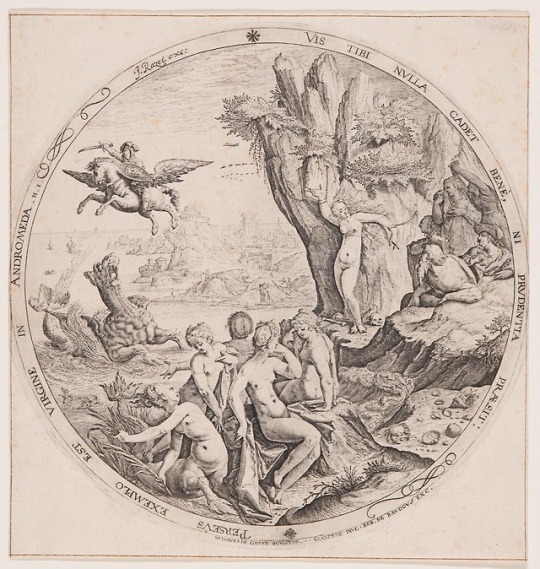

Perseus osvobozuje Andromedu (Perseus Freeing Andromeda), Karel van Mader (designer) & Jacques de Gheyn II. (engraver), 1588
This engraving was made soon after de Gheyn left Goltzius's workshop and began to publish his own works with Amsterdam publishers. In this period, he often worked from designs by Karel van Mander (1548-1606), the worldly-wise artist who earned distinction in Rome and in Vienna as an assistant to Bartholomeus Spranger. Van Mander returned to Haarlem in 1583 and at the end of the decade, de Gheyn began to collaborate with him, creating 48 prints from van Mander's designs. The engraver was able to adjust his style to the pictorial elegance of the designs which he reproduced by way of subtle incisions. Their characteristic silver tone and dreamy artistic expression distinguishes them from the plastic volumes of Hendrick Goltzius and his followers.
It is currently part of the Schwarzenberg Palace gallery in Prague
31 notes
·
View notes
Photo

Osvobození Andromedy (The Release of Andromeda), Michael Willman (1630 - 1706), after 1682
In this painting, Willman openly avowed to the works of the renowned Flemish master, Peter Paul Rubens. He particularly adopted the type of female figures of full shapes and fine flesh tone. He used several layers of glazes in the painting, thus generally refining the colour scheme, in which pink and grey-blue tones predominate. This work was commissioned by Count Christoph Wenzel Nostitz for his palace in Lobris, Silesia. The subject is based on Ovid’s Metamorphoses: chained to the rock, the royal daughter Andromeda is to become a victim of a sea monster. However, the hero Perseus arrives on the winged horse Pegasus to free her and falls in love with her. Ovid’s text can also be explained as a story of the human soul endangered by the devil in the form of the sea monster, which is liberated by Perseus symbolizing Christ.
It is currently part of the Schwarzenberg Palace gallery in Prague
4 notes
·
View notes
Photo

Nanebevzetí Panny Marie (The Assumption), Jan Kryštof Liška (1650 - 1712), c. 1696
This canvas is closely related to the painting of the same subject, The Assumption, which Liška delivered for the high altar of the Cistercian monastic church in Osek, and it can be considered an ideal sketchy design. Its composition is interesting – the Assumpta, usually depicted at the top of the image, is placed in the centre of the action in this case, forming a link between the earthly and heavenly spheres. The pictorial surface is made dynamic by a great number of figures, whirling along the uprising curves. Light is also very important in forming the composition, accentuating the dominant points of meaning – the lit empty tomb surrounded by old men, the figure of God’s Mother, who is simultaneously presented as an apocalyptic woman, dressed in sunrays, and the Holy Trinity, welcoming the Virgin.
It is currently part of the Schwarzenberg Palace gallery in Prague
5 notes
·
View notes
Photo

Zlický kníže Radslav se koří svatému Václavu (Prince Radslav of Zlice Humbles Himself before St. Wenceslas), Karel Škréta (1610 - 1674), c. 1641
Prince Radslav of Zlice Humbling Himself before St. Wenceslas is the 18th painting of the St. Wenceslas Cycle, created by Karel Škréta together with other artists for the Monastery of Discalced Augustinians at Zderaz beginning in 1640. The scene depicts the moment of the clash of the leaders of the enemy armies at Kouftm, who were to fight each other in a duel. The picture captures the instant when Radslav humbly kneels before the saint, begging for mercy, for the sign of the cross on the forehead of St. Wenceslaus, as well as the pair of angels appearing at his side, clearly showed that the Grace of God was with him. The inscription "NON MARTE SED ARTE" (not by the power of war but by the art of the Cross) suspended above the head of St. Wenceslas illustrates the general meaning of the scene. The painting is captivating for its compelling rendering of the atmosphere of war and its elaborate composition, as well as for the robust realism evident in the portrayal of the figures of the soldiers. Although in some sections Škréta entrusted work on the painting to his assistants, the contrast of the dark silhouette of the saint and the ethereal aspect of the angels is incredibly powerful.
It is currently part of the Schwarzenberg Palace gallery in Prague
1 note
·
View note
Photo

Panna Maria se čtyřmi světci (Virgin Mary with Four Saints), Antonín Kern (1709 - 1747), painted 1734-1737
The narrative of the painting is suggested by a fine gesture of the elegantly dressed St. Margaret, who is leading a dragon - the devil on a chain. According to a legend the latter first devoured her, but in the end she came out of his entrails alive. The main figures of the composition are the Madonna and Child, accompanied by two patron saints of Bohemia. The one wearing an ermine mantle and the princely cap is St. Wenceslas, whereas St. John of Nepomuk is presenting the symbol of his silence for which he was tortured and killed - his own tongue on a shell. Behind him, clad as a Franciscan and holding a white lily, is St. Antony of Padua, who was renowned for his preaching activities and brilliant elocution. The eloquence of St. Antony was thus contrasted with John’s preserved silence.
It is currently part of the Schwarzenberg Palace gallery in Prague
14 notes
·
View notes
Photo

Podobizna malíře miniatur Karla Bruniho (Portrait of the Miniaturist Karl Bruni - or of an unknown nobleman), Jan Kupecký (1666 - 1740), 1709
One of the most elaborated of Kupecký’s portraits was painted during his stay in Vienna, where his style achieved more elegance and his technique became more precise. The represented figure is probably the Viennese painter of miniatures Karl Bruni (1653? - 1714), who was a witness at Kupecký’s wedding in the year the portrait was made. The luxurious and costly costume can however also suggest that this is a nobleman, whose hobby is miniature painting. Kupecký depicted his model in a relaxed position with a small brush and an oval miniature in his hand. The right-hand side features a view through to an obelisk and a circular ancient-like temple. These motifs can be understood as either symbols of glory or a personal recollection from the sitter’s travels - most probably around Italy.
It is currently part of the Schwarzenberg Palace gallery in Prague
7 notes
·
View notes
Photo


Krajina s antickými ruinami (Landscape with Ancient Ruins), Josef Platzer (1751 - 1806), before or around 1780
Zříceniny s fontánou (Ruins with a Fountain), Josef Platzer, 1780s
Platzer was one of the most significant practitioners of theatre art at the turn of the 19th century. He is firmly connected with stage designs for theatres in Vienna, where he also became a member of the Academy. Platzer’s paintings were always preceded by numerous painstakingly rendered sketches - after all his diligince in drawing can be supported by the painter himself: “I throw graphite and colour on paper in the hours when others throw dice and cards on tables, and I do it solely out of playfulness.” In his work Platzer could not deny being the son of the famous Prague sculptor, Ignaz Franz Platzer. His paintings of architecture thus often include works of sculpture - as for example Neptune’s Fountain, which appears in both works.
They are currently part of the Schwarzenberg Palace gallery in Prague
4 notes
·
View notes
Photo





Krajina s troskami okrouhlého chrámu (Landscape with the Ruins of a Circular Temple), Norbert Grund (1717 - 1767), c. 1760
Grund’s poetic depiction of the scene and its idyllic atmosphere conceal a symbol of extinction and end of all worldly things - the landscape at nightfall with the range of mountains in the background will soon be veiled by darkness, which will consume the ruins of the little temple in the foreground of the composition. The waning fame of the sanctuary, consecrated to Venus, the goddes of love (or, according to earlier interpretations, to Diana), is animated by figures of nymphs, one of whom worships the goddes with a burnt offering. Capricious satyrs are ready to tempt the graceful nymphs to erotic rollicking. The construction of the space of the painting is very close to the Baroque stage-like concept, whose primary characteristic was the building of illusive spatial depth.
It is currently part of the Schwarzenberg Palace gallery in Prague
55 notes
·
View notes
Photo

Vestálka Claudie Quinta (The Vestal Claudia Quinta), Jan Rudolf Bys (1662 - 1738), 1692
Bys made use of a subject that was not common in Bohemia. The main heroine of this scene is a Vestal - priestess of the temple of the Roman goddess Vesta, who was a protectress of the hearth. Young girls coming mostly from rich families kept the sacred fire in the temple and were compelled to live in absolute pureness and chastity. The breaking of the vows resulted in a cruel death from being buried alive. The Vestal Claudia Quinta was accused of not keeping her commitments. To prove her innocence she released a large boat that was stranded in the sands of the River Tiber with a mere thin belt. Bys represented the Vestal with the belt in her hand and her hair veiled. She is standing next to the sculpture of Goddess Cybele, who helped to save her life with a miracle. This painting has a pendant in the composition Penelope and Her Suitors.
It is currently part of the Schwarzenberg Palace gallery in Prague
18 notes
·
View notes
Photo

Orfeus se zvířaty v krajině (Orpheus with Animals in a Landscape), Václav Vavřinec Reiner (1689 - 1743), before 1720
The theme of Orpheus playing the lyre (here, the harp) amidst a gathering of beasts provided a great opportunity for the artist to show off his abilities in painting various species of animals. Reiner represented the great mythical poet as a young man with a laurel wreath, which refers to his victories in various contest in poetry and singing. With his performance, Orpheus was able to mesmerize nature and animals - even the wild ones became tame and peaceful in his company. He even fascinated Pluto, the king of the underworld, where his beloved nymph arrived after her death. Orpheus’ story became a parallel to the subject of Christ as a shepherd seated in the middle of a herd, and his taming of animals was reminiscent of Christ’s influence over the sinners. The painting comes from the famous collection of the Nostitz counts and it might be possible that the face of Orpheus is a crypto portrait of one of the family’s members.
Currently, it is a part of the Schwarzenberg Palace gallery in Prague
37 notes
·
View notes
Photo



Natalie Dormer photographed for Picnic at Hanging Rock.
3K notes
·
View notes
